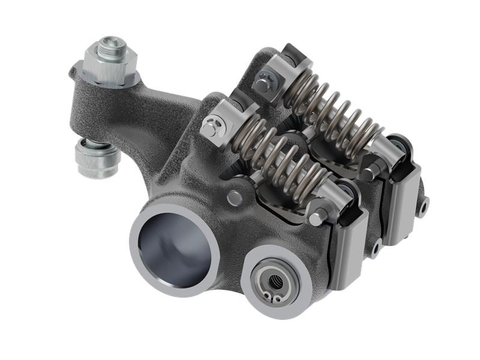Testing measured fuel consumption and exhaust temperature, from which engine-out NOx and CO2 were determined. Results indicated the CDA created up to a 38% reduction of NOx compared with 13% for LIVC thanks to exhaust gasses temperature increase, which enables optimal emissions aftertreatment performance. The results were delivered while simultaneously reducing CO2 emissions.
During the evaluation, the standard valvetrain on an 11-liter diesel engine was replaced with Eaton’s variable valve actuation system able to deliver either CDA or LIVC functions. The engine was put on a dynamometer and tested in standard engine and in varying CDA and LIVC engine modes to determine optimal thermal management effects and fuel savings.
“Emissions regulations are driving the adoption of variable valve actuation solutions by our global commercial vehicle customers,” said Fabiano Contarin, product director, Commercial Vehicle Valve Actuation, Eaton’s Vehicle Group. “Our portfolio of technologies is helping manufacturers meet the upcoming regulations in a number of ways based on customer preference.”
Eaton’s CDA also resulted in a 3% decrease in fuel consumption in a low-load cycle, while LIVC lowered fuel consumption by 0.5%. Additionally, CDA in three-cylinder mode raised exhaust temperatures up to 175 degrees Celsius which helped increase the efficiency of a selective catalytic reduction (SCR) system.
The study results confirm earlier findings of tests conducted in the U.S. by Eaton and the Southwest Research Institute (SwRI), one of the oldest and largest independent, nonprofit applied research and development organizations. The findings of the U.S.-based tests found using CDA and a close-coupled selective catalytic reduction (SCR) catalyst reduced CO2 emissions by 4% in a low load cycle with NOx emission of 0.02 g/hp-hr.
“If a low-load cycle is a customer’s focus, then CDA is the ideal technology,” Contarin said. “LIVC, instead, provides lower benefits but in a wider range of the engine map, especially when combined with a higher compression ratio.”
Learn more about Eaton’s variable valve actuation solutions.
Eaton is an intelligent power management company dedicated to improving the quality of life and protecting the environment for people everywhere. We are guided by our commitment to do business right, to operate sustainably and to help our customers manage power ─ today and well into the future. By capitalizing on the global growth trends of electrification and digitalization, we’re accelerating the planet’s transition to renewable energy, helping to solve the world’s most urgent power management challenges, and doing what’s best for our stakeholders and all of society.
Founded in 1911, Eaton is marking its 100th anniversary of being listed on the New York Stock Exchange. We reported revenues of $20.8 billion in 2022 and serve customers in more than 170 countries. For more information, visit www.eaton.com. Follow us on Twitter and LinkedIn.





